The Oncolytic Adenovirus Market is estimated to be valued at USD 140.2 billion in 2025 and is projected to reach USD 288.9 billion by 2035, registering a compound annual growth rate (CAGR) of 7.5% over the forecast period.
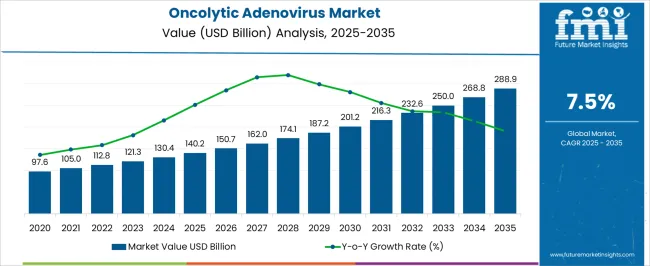
| Metric | Value |
|---|---|
| Oncolytic Adenovirus Market Estimated Value in (2025 E) | USD 140.2 billion |
| Oncolytic Adenovirus Market Forecast Value in (2035 F) | USD 288.9 billion |
| Forecast CAGR (2025 to 2035) | 7.5% |
The Oncolytic Adenovirus market is progressing steadily due to its increasing role in targeted cancer therapy and immuno-oncology. The current market is influenced by a rising number of clinical trials and growing investments in virus-based cancer treatment platforms by biotechnology firms and academic institutions. Regulatory authorities across regions have shown a more adaptive stance toward fast-tracking breakthrough therapies, which is supporting the clinical adoption of oncolytic adenoviruses.
The ability of these viruses to selectively replicate within tumor cells and stimulate systemic anti-tumor immune responses has been frequently cited in oncology journals and scientific communications as a critical advancement. Future outlook remains promising as combination strategies with immune checkpoint inhibitors and gene therapy constructs are further explored.
Press releases and investor presentations from biotech companies also reflect optimism about scalability, manufacturing readiness, and the potential for addressing treatment-resistant cancers With the oncology landscape evolving rapidly, oncolytic adenoviruses are expected to play a crucial role in precision medicine strategies targeting solid and metastatic tumors.
The market is segmented by Type and Application and region. By Type, the market is divided into Adenoviruses-based Oncolytic Viruses, HSV-based Oncolytic Viruses, and Others. In terms of Application, the market is classified into Melanoma, Prostate Cancer, Breast Cancer, Ovarian Cancer, Lung Cancer, and Others. Regionally, the market is classified into North America, Latin America, Western Europe, Eastern Europe, Balkan & Baltic Countries, Russia & Belarus, Central Asia, East Asia, South Asia & Pacific, and the Middle East & Africa.
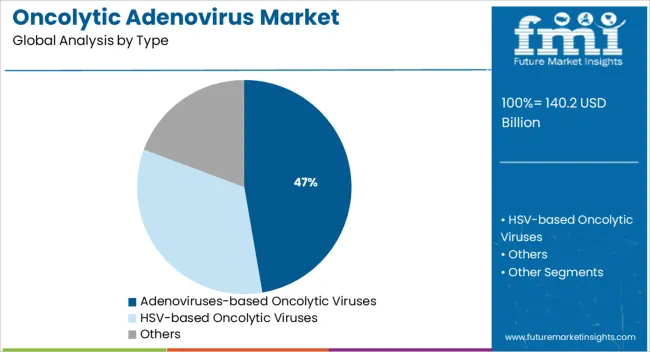
The adenoviruses-based oncolytic viruses segment is projected to contribute 47.3% of the Oncolytic Adenovirus market revenue share in 2025, making it the most prominent type in the market. This position has been supported by the extensive research background of adenoviruses and their ability to be genetically engineered with high precision.
Scientific literature and institutional publications have emphasized their well-characterized genome and efficient transduction capability, which have made them highly adaptable for tumor-specific replication. Adenovirus-based vectors have been noted in clinical trial data to demonstrate strong immunogenicity and safety profiles, which have encouraged their use in multiple therapeutic pipelines.
Furthermore, ease of production and established scalability in GMP environments have allowed biopharmaceutical companies to progress these vectors rapidly through preclinical and clinical development These attributes have collectively enhanced their attractiveness as a reliable oncolytic platform and supported their dominant revenue share in the current market landscape.
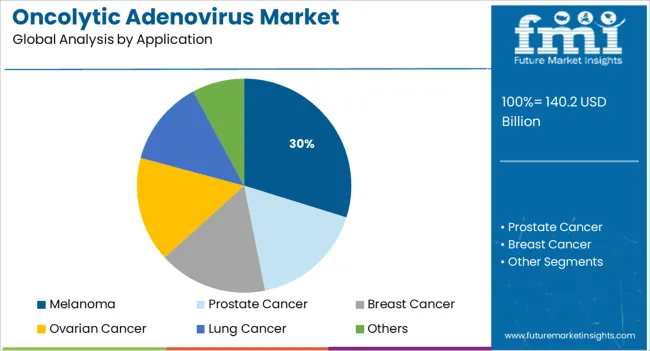
The melanoma segment is expected to hold 29.8% of the Oncolytic Adenovirus market revenue share in 2025, positioning it as the leading application segment. This growth has been largely driven by the immunogenic nature of melanoma tumors, which makes them highly responsive to viral immunotherapy. Peer-reviewed oncology journals have highlighted that melanoma is often targeted in early-phase oncolytic virus trials due to its accessible tumor sites and favorable immune environment.
Clinical updates from biotechnology firms and cancer research centers have indicated encouraging response rates when adenovirus-based therapies are used as monotherapies or in combination with immune checkpoint inhibitors. Additionally, advancements in tumor antigen targeting and viral delivery mechanisms have further enhanced the therapeutic outcomes in melanoma cases.
The rising incidence of melanoma, along with increased awareness and screening efforts, has further reinforced the need for novel treatments These factors have played a key role in securing the segment’s lead in 2025 and sustaining its momentum for continued clinical focus.
According to market research and competitive intelligence provider Future Market Insights- the market for oncolytic adenovirus reflected a value of 4.9% during the historical period, 2020 to 2025.
The increasing prevalence of different types of cancers is a significant factor driving the market's growth. In addition, the presence of various immunotherapies to treat cancer at different stages in creating a positive demand for oncolytic adenovirus. Furthermore, the COVID-19 pandemic affected the research and development activities related to oncolytic adenovirus due to the disruption in the supply chain demand globally.
Thus, the market for Oncolytic adenovirus is expected to register a CAGR of 7.5% in the forecast period 2025 to 2035.
Improving patient outcomes by advancing the science and application of oncolytic adenovirus
The presence of various government and non-government organizations that create awareness and promote research is augmenting market expansion. For instance, Cancer Research Institute funded more than 120 clinical trials and invested around USD 474 Billion in research. Moreover, the Society for Immunotherapy of Cancer(SITC) is engaged in improving patient outcomes by advancing the science and application of oncolytic adenovirus. These organizations are working with scientists and researchers to discover novel treatment regimens of immune therapy.
Furthermore, increasing funding for the development of novel treatments is expected to boost Research and Development activities to develop cancer immunotherapy. For instance, in June 2025, Stanford scientists received USD 13 Billion from Cancer Grand Challenges, a funding initiative by Cancer Research UK and the US National Cancer Institute. This funding is awarded for the development of next-generation immunotherapies, the study of extrachromosomal DNA, and the investigation of early-stage malignancies.
Increasing approval of novel immunotherapies is anticipated to propel the market growth over the forecast period. From 2024 to 2025, the USA FDA has approved various anti-PD-1/L1 antibodies such as nivolumab, atezolizumab, avelumab, dostarlimab, and others for the treatment of NSCLC, renal cell carcinoma, melanoma, breast, prostate malignancies, and others. The higher approvals of immunotherapeutic agents have propelled the market growth.
Strategic initiatives by leading players propelling the market growth
Various Strategic initiatives undertaken by leading players are also expected to facilitate the market demand. For instance, in August 2025, BioNTech SE and Genmab A/S expanded their strategic collaboration for the development and launch of new immune therapies for the treatment of various cancer forms. Moreover, in March 2025, Merck & Co., Inc announced the approval of KEYTRUDA from the US FDA. KEYTRUDA is an anti-PD-1 therapy for treating advanced endometrial carcinoma.
However, side effects associated with immunotherapy will likely hamper the cancer treatment prescription rate. The available therapies are associated with several adverse effects, such as pain, insomnia, fatigue, nausea, and gastrointestinal conditions. These adverse effects impact the overall quality of life of patients and the management of these adverse effects incurs extra costs. In addition, prolonged consumption of immunotherapeutic drugs may cause severe damage to the organs and increase the incidence of organ failure cases.
Antiviral immune response creating challenges for the oncolytic adenovirus market
Although oncolytic adenovirus has remarkable antitumor potency, it is confronted with tough challenges such as antiviral immune response and obstruction of the tumor microenvironment (TME). This has led to a significant debate on the efficiency and application of oncolytic adenovirus for cancer treatment.
Furthermore, the time taken for approval of therapies and medications for cancer is derailing the progress of the market. In addition, the efficiency of drugs and their long-lasting impact is still being tested. All these factors are hampering the growth of the oncolytic adenovirus market.
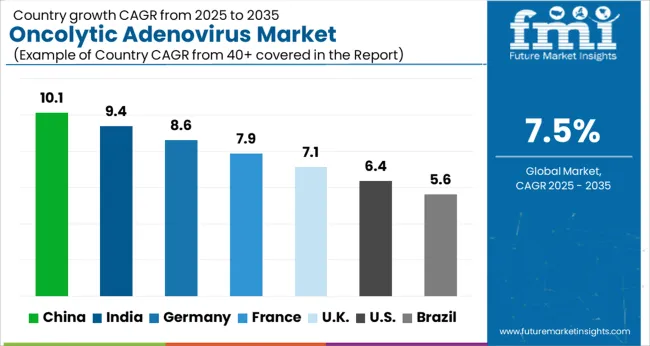
Government and non-government organizations supporting research activities for oncolytic adenovirus in North America
In 2025, North America led the overall market in terms of revenue due to the presence of a large number of leading players coupled with various Strategic initiatives undertaken by them. Moreover, the increase in disease prevalence, various government and non-government organizations promoting research activities for cancer immunotherapy, and the increasing approval of novel drugs are fueling the regional market growth. For instance, in April 2025, the US FDA approved Opdivo (nivolumab) for treating NSCLC in adult patients.
Thus, North America is expected to possess a 43% market share for the oncolytic adenovirus market in 2025.
Investments in research and healthcare infrastructure create lucrative opportunities for the oncolytic adenovirus market
Asia Pacific is projected to witness the fastest growth rate over the forecast period. The increase in the geriatric population, a large patient base of targeted diseases, and improving healthcare infrastructure are some of the primary factors driving the growth.
Moreover, the rising regulatory approvals of immune therapies in the region are also contributing region’s expansion. For instance, from 2024 to 2025, the National Medical Products Administration of China approved Pembrolizumab and Durvalumab to treat esophageal cancer and SCLC.
Thus, Asia Pacific is expected to possess a 39% market share for the oncolytic adenovirus market in 2025.
Product approval for treating lung cancer boosting segment growth
The rising prevalence of lung malignancies, increasing adoption of immunotherapy, rise in awareness programs, and presence of a robust pipeline of investigational candidates are some of the key factors expected to drive the segment's growth. Furthermore, rising product approval and product launches fueling the demand forward. For instance, in October 2024, the US FDA approved Tecentriq (atezolizumab) to treat stage II and stage III NSCLC.
Thus, lung cancer is expected to possess a 35% market share for oncolytic adenovirus in 2025.
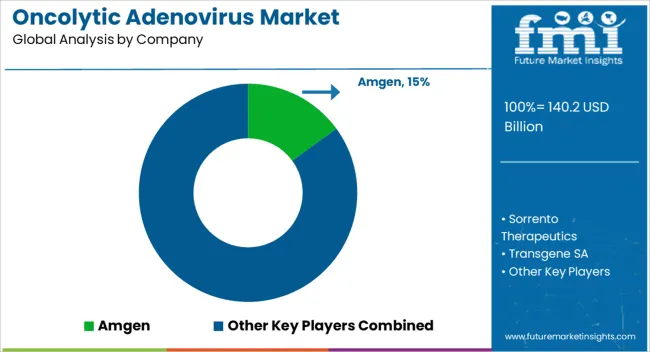
Key players in the oncolytic adenovirus market are Amgen, Sorrento Therapeutics, Transgene SA, Oncolys BioPharma, Targovax, Lokon Pharma, Vyriad, TILT Biotherapeutics, CG Oncology Inc, VCNBiosciences, DNAtrix, Replimune Group Inc
| Report Attribute | Details |
|---|---|
| Market Value in 2025 | USD 140.2 billion |
| Market Value in 2035 | USD 288.9 billion |
| Growth Rate | CAGR of 7.5% from 2025 to 2035 |
| Base Year for Estimation | 2024 |
| Historical Data | 2020 to 2025 |
| Forecast Period | 2025 to 2035 |
| Quantitative Units | Revenue in USD Billion and CAGR from 2025 to 2035 |
| Report Coverage | Revenue Forecast, Volume Forecast, Company Ranking, Competitive Landscape, Growth Factors, Trends, and Pricing Analysis |
| Segments Covered | Type, Application, Region |
| Regions Covered | North America; Latin America; Western Europe; Eastern Europe; Asia Pacific Excluding Japan; Japan; Middle East and Africa (MEA) |
| Key Countries Profiled | The USA, Canada, Brazil, Argentina, Germany, The UK, France, Spain, Italy, Nordics, BENELUX, Australia & New Zealand, China, India, Association of Southeast Asian Nations, GCC Countries, South Africa |
| Key Companies Profiled | Amgen; Sorrento Therapeutics; Transgene SA; Oncolys BioPharma; Targovax; Lokon Pharma; Vyriad; TILT Biotherapeutics; CG Oncology Inc; VCNBiosciences; DNAtrix; Replimune Group Inc |
| Customization | Available Upon Request |
The global oncolytic adenovirus market is estimated to be valued at USD 140.2 billion in 2025.
The market size for the oncolytic adenovirus market is projected to reach USD 288.9 billion by 2035.
The oncolytic adenovirus market is expected to grow at a 7.5% CAGR between 2025 and 2035.
The key product types in oncolytic adenovirus market are adenoviruses-based oncolytic viruses, hsv-based oncolytic viruses and others.
In terms of application, melanoma segment to command 29.8% share in the oncolytic adenovirus market in 2025.
Explore Similar Insights

Thank you!
You will receive an email from our Business Development Manager. Please be sure to check your SPAM/JUNK folder too.
Chat With
MaRIA